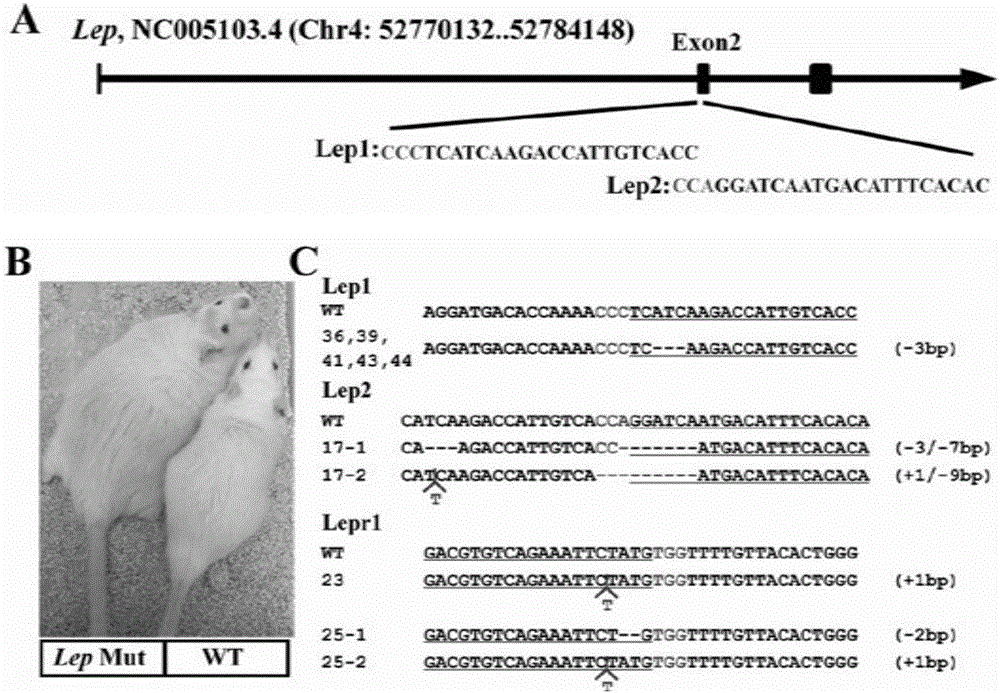Animal model for obese rats and establishing method
A construction method and gene technology, applied in the field of animal genetic engineering and genetic modification, can solve the problems of lack of stem cell lines, inability to fully simulate the real situation of human diseases, time-consuming and other problems
- Summary
- Abstract
- Description
- Claims
- Application Information
AI Technical Summary
Problems solved by technology
Method used
Image
Examples
Embodiment 1
[0030] Embodiment 1 is aimed at the construction of the CRISPR-Cas9 expression system of Lep ( figure 1 )
[0031] 1. According to the sequence of rat Lep and LEPR (leptin receptor), design sgRNA and obtain the sequence information of sgRNA. The DNA sequence of the sgRNA specifically targeting the second exon of the Lep gene is shown in SEQ ID NO.1 and SEQ ID NO.2; the sgRNA specifically targeting the second and third exons of the Lepr gene, The DNA sequences thereof are respectively shown in SEQ ID NO.3 and SEQ ID NO.4. Among them, SEQ ID NO.1 and SEQ ID NO.2 target SEQ ID NO.5 (SEQ ID NO.5 is a part of the LEP gene), while SEQ ID NO.3 and SEQ ID NO.4 target SEQ ID NO. 6 and 7 (SEQ ID NO. 6 and 7 are part of LEPR gene, respectively). Each sequence of SEQ ID NO.1-4 is a double-stranded DNA formed by annealing. Take SEQ ID NO.1 as an example: Synthesize positive and negative single-stranded Seq ID No1-ss and Seq ID No1-as respectively, and then anneal to form SEQ ID NO.1. ...
Embodiment 2
[0041] Example 2 In vitro transcription
[0042] Use T7-Cas9 PCR and T7-sgRNA PCR products to perform in vitro transcription mediated by T7 promoter, that is, use T7 promoter as the promoter of in vitro transcription, and use RNA polymerase to realize the transcription process from DNA to mRNA in vitro. The specific method For: use mMESSAGE mMACHINE T7ULTRA kit (Life Technologies) to transcribe T7-Cas9 PCR products in vitro, and use MEGAshortscript T7 kit (Life Technologies) to transcribe T7-sgRNA PCR products in vitro. The mRNA produced by transcription was purified. The specific method was: Cas9 mRNA was purified by MEGAclear kit (Life Technologies), sgRNAs were purified by ethanol precipitation, mRNA was dissolved in pure water, and the concentration of purified mRNA was measured by spectrophotometer. T7-Cas9 PCR primers are shown in Table 4, T7-sgRNA PCR primers are shown in Table 5, gRNA-Lep1-F, gRNA-Lep2-F, gRNA-LepR1-F, gRNA-LepR2-F are respectively for SEQ ID NO.1- Th...
Embodiment 3
[0051] Example 3 Using the CRISPR-Cas9 system mRNA for Lep / LEPR to produce gene-targeted rats
[0052] 1. Pronuclear injection and embryo transfer
[0053] The pronuclear stage fertilized eggs of rats were taken, and the premixed Cas9mRNA / sgRNA mixture (the final concentration of Cas9mRNA was 100ng / μl, and the final concentration of sgRNA was 50ng / μl) was injected into the cytoplasm of rat fertilized eggs using a microinjector, and then Transplant into the oviduct of the recipient mother mouse to produce gene-targeted rats, and the injection volume is 0.5-1ul.
[0054] 2. Identification of gene targeting rats
[0055] After the birth of the surrogate mother mouse, cut off about 1 cm of mouse tail when the offspring grow to 2 weeks old, digest with proteinase K at 55°C, and extract the mouse tail genome by phenolform extraction. Using the mouse tail genome as a template, primers were designed for the 2nd exon of the Lep gene and the 2nd and 3rd exons of the LEPR gene for ampl...
PUM
 Login to View More
Login to View More Abstract
Description
Claims
Application Information
 Login to View More
Login to View More - R&D
- Intellectual Property
- Life Sciences
- Materials
- Tech Scout
- Unparalleled Data Quality
- Higher Quality Content
- 60% Fewer Hallucinations
Browse by: Latest US Patents, China's latest patents, Technical Efficacy Thesaurus, Application Domain, Technology Topic, Popular Technical Reports.
© 2025 PatSnap. All rights reserved.Legal|Privacy policy|Modern Slavery Act Transparency Statement|Sitemap|About US| Contact US: help@patsnap.com



